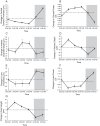Ocular Biometric Diurnal Rhythms in Emmetropic and Myopic Adults
- PMID: 30372744
- PMCID: PMC6203176
- DOI: 10.1167/iovs.18-25389
Ocular Biometric Diurnal Rhythms in Emmetropic and Myopic Adults
Abstract
Purpose: To investigate diurnal variations in anterior and posterior segment biometry and assess differences between emmetropic and myopic adults.
Methods: Healthy subjects (n = 42, 23-41 years old) underwent biometry and spectral-domain optical coherence tomography imaging (SD-OCT) every 4 hours for 24 hours. Subjects were in darkness from 11:00 PM to 7:00 AM. Central corneal thickness, corneal power, anterior chamber depth, lens thickness, vitreous chamber depth, and axial length were measured. Thicknesses of the total retina, photoreceptor outer segments + RPE, photoreceptor inner segments, and choroid over a 6-mm annulus were determined.
Results: All parameters except anterior chamber depth demonstrated significant diurnal variations, with no refractive error differences. Amplitude of choroid diurnal variation correlated with axial length (P = 0.05). Amplitude of axial length variation (35.71 ± 19.40 μm) was in antiphase to choroid variation (25.65 ± 2.01 μm, P < 0.001). The central 1-mm retina underwent variation of 5.03 ± 0.23 μm with a peak at 12 hours (P < 0.001), whereas photoreceptor outer segment + RPE thickness peaked at 4 hours and inner segment thickness peaked at 16 hours. Diurnal variations in retina and choroid were observed in the 3- and 6-mm annuli.
Conclusions: Diurnal rhythms in anterior and posterior segment biometry were observed over 24 hours in adults. Differences in baseline parameters were found between refractive error groups, and choroid diurnal variation correlated with axial length. The retina and choroid exhibited diurnal thickness variations in foveal and parafoveal regions.
Figures







References
-
- Fujiwara T, Imamura Y, Margolis R, Slakter JS, Spaide RF. Enhanced depth imaging optical coherence tomography of the choroid in highly myopic eyes. Am J Ophthalmol. 2009;148:445–450. - PubMed
-
- Read SA, Collins MJ. Diurnal variation of corneal shape and thickness. Optom Vis Sci. 2009;86:170–180. - PubMed
Publication types
MeSH terms
Grants and funding
LinkOut - more resources
Full Text Sources

